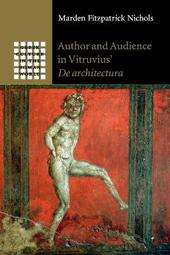
|
Author and Audience in Vitruvius' De architectura
Paperback / softback
Main Details
| Title |
Author and Audience in Vitruvius' De architectura
|
| Authors and Contributors |
By (author) Marden Fitzpatrick Nichols
|
| Series | Greek Culture in the Roman World |
|---|
| Physical Properties |
| Format:Paperback / softback | | Pages:264 | | Dimensions(mm): Height 229,Width 152 |
|
| Category/Genre | Ancient and classical art BCE to c 500 CE
History of architecture |
|---|
| ISBN/Barcode |
9781108969253
|
| Classifications | Dewey:720 |
|---|
| Audience | | Professional & Vocational | |
|---|
| Illustrations |
Worked examples or Exercises
|
|
Publishing Details |
| Publisher |
Cambridge University Press
|
| Imprint |
Cambridge University Press
|
| Publication Date |
17 December 2020 |
| Publication Country |
United Kingdom
|
Description
Vitruvius' De architectura is the only extant classical text on architecture, and its impact on Renaissance masters including Leonardo da Vinci is well-known. But what was the text's purpose in its own time (ca. 20s BCE)? In this book, Marden Fitzpatrick Nichols reveals how Vitruvius pitched the Greek discipline of architecture to his Roman readers, most of whom were undoubtedly laymen. The inaccuracy of Vitruvius' architectural rules, when compared with surviving ancient buildings, has knocked Vitruvius off his pedestal. Nichols argues that the author never intended to provide an accurate view of contemporary buildings. Instead, Vitruvius crafted his authorial persona and remarks on architecture to appeal to elites (and would-be elites) eager to secure their positions within an expanding empire. In this major new analysis of De architectura from archaeological and literary perspectives, Vitruvius emerges as a knowing critic of a social landscape in which the house made the man.
Author Biography
Marden Fitzpatrick Nichols is Assistant Professor of Classics at Georgetown University, Washington, DC. She works primarily on the literature, art, and culture of Ancient Rome.
Reviews'Nichols has produced an exceptional book that will inevitably shape the scholarly conversation about Vitruvius the author for some time to come. That it is a book of such high quality in so many respects - including production - is fortunate indeed.' John Matthew Oksanish, Bryn Mawr Classical Review
|